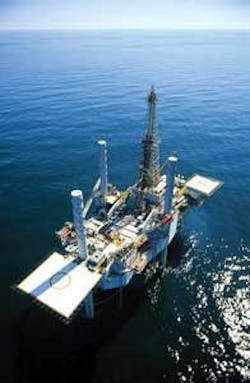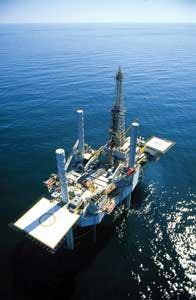VESSELS, RIGS & SURFACE SYSTEMS
2009 predicted to be a tough year for offshore rigs
The latest headlines from many newspapers and magazines paint a grim picture for 2009 – “slumping economy, credit crunch, recession, plunging oil prices.” The current state of the economy is predicted to result ultimately in fewer offshore rigs on the market in 2009, a drop in utilization, and eventually a drop in day rates. While some new rigs continue to be built, some contractors are having a hard time finding financing, resulting in canceled orders.
Commonplace in today’s economy is for existing rigs to be stacked once a contract is up, as owners wait for better economic times. Established companies with cash resources seem to be fairing better, and continue moving forward. Many factors go into determining which of the categories a company fits.
Brian Uhlmer, research analysis with Pritchard Capital Partners LLC, says companies that have cash flow and are viewed as solid continue to be able to obtain credit. “However, for the speculative guys, even with contracted rigs, we have seen credit cut off.”
Like Scorpion Offshore, which was unable to secure financing for itsDeepwater Rig a semisubmersible Keppel FELS in Singapore was to build. Scorpion already had invested about $74 million into it, according to Uhlmer. Despite the fact that Scorpion has operational experience and has jackups currently in operation to create some cash flow, and despite the fact that the semisub was contracted with Petrobras and being built at a well-known yard, it did not find financing.
Seadrill announced in January that it has amended its agreements with PPL Shipyard and Keppel FELS for the construction of four new jackups — postponing payments. Seadrill has issued corporate guarantees for the remaining installments on the first two units. However, no guarantees were made for payments on the second units at the yards.
“But they also are trying to buy Scorpion which has seven jackups -- so they had to make a decision and they realized it would be cheaper to average in and buy all of Scorpion,” Uhlmer said (prior to the official announcement from Seadrill).
Rig utilization
Uhlmer says there has not been a drop in working rigs — not yet anyway. “But there have been a couple of floaters come off without follow-on contracts.” For example, the second generation semisubmersibleAtwood Southern Cross now is sitting idle, which, according to Uhlmer, “no one thought that would be a problem back in June.”
Another example is Diamond Offshore’sOcean Victory fourth generation semisubmersible. It still awaits contract resolution with Callon Petroleum and is on standby until March. The two-well, six-month contract was to drill and complete Callon’s Entrada field wells in the Gulf of Mexico beginning in October 2008. In November, Callon announced it had decided to suspend operations to develop Entrada field due to “significantly higher than expected costs incurred to date and commodity prices which have declined to less than half of their levels when development operations began in mid-2008.” Callon said it does not anticipate returning to the project.
The good news for Diamond is thatOcean Victory is contracted to start work for ATP in March for a minimum of one year.
“Utilization drop and idle time is a precursor to day rate drops -- not the other way around,” Uhlmer says. “Rigs have to sit idle for a while and there have to be a lot of rigs idle before people start to get desperate.”
Worldwide offshore rig fleet utilization was at 87.7% in early January, according to ODS Petrodata, down only slightly year-over-year.
Hercules Offshore, the drilling rig contractor with the most exposure to the weakening shallow water market in the GoM, has cold stacked a number of its regional jackups, submersibles, and inland barges until demand improves. The company has only four rigs contracted to work in the GoM post 1Q 2009.
In Pride International’s latest monthly fleet update, the company announced its jackupPride Nevada, whose contract ended in December, has been stacked. Pride Mississippi was stacked after its contract was up in October. And earlier in the year, Pride Alabama and Pride Colorado took the same path as Pride Utah did in 2007.
The latest to stack a rig is Transocean. In its January fleet status report, theTransocean Nordic is listed as stacked.
According to Pritchard, the jackup was to be sold to a Kuwaiti company for $170 million. “In December 2008, the sale agreement was terminated,” says Transocean’s report. This is the second sale that has been terminated in recent months, Pritchard says.
Transocean also terminated a contract with Burgundy Global Exploration Corp. when Burgundy failed to post the required escrow.
The second half of 2009 could prove challenging, as more contracts are scheduled to expire for several major drilling contractors.
Day rates
For 2009, Uhlmer predicts a 10-15% reduction in rates for premium jackups. For commodity style jackups, 250s and below, he thinks there will be a 30-40% decline, as well as significant idle time. With the way jackups are rolling over, it probably will be around March before a reduction is seen, he adds.
GoM commodity jackups have been affected the most, as rates have already dropped from $70,000 to $50,000, Uhlmer says. This is followed by the international commodity jackups.
And floaters are predicted to head the same direction. “The midwaters are probably going to be hit with some idle time and 30-40% reduction [in rates].” For ultra deepwater, Uhlmer says he is modeling new contract day rates around $550,000. The peak price in 2008 was $650,000. “There’s also not a lot available in the ultra deepwater, so I don’t even know if we will see contract announcements.”
The last deepwater rate Uhlmer saw was $585,000 which is about a 10% drop from the $650,000 high. Uhlmer says he has not seen any new contracts on midwaters.
“Midwater has some marginal prospects; if you are going to drill some of those prospects you need commodity prices to support it and also you need the lenders to help pay for that drilling program. If you are a smaller producer, and it is not within your cash flow to drill, you have to borrow the money to drill. So if they won’t lend you any money – you are not drilling.”
The average worldwide day rate for jackups rated to work in water depths greater than 300 ft (91 m) has fallen about 6% since September 2008, according to ODS Petrodata, although rates for rigs rated for lesser water depths so far have remained relatively stable.
When will it rebound?
“I do not think premium jackups are going to fall off that much. I cannot see the commodity jackups rebounding in 2009 at all after they fall off. That will have to be sometime in 2010. So many of these jackups, rigs in general, but even jackups, are getting more than two-year terms now, so you do not have a lot of rollovers, so that is why rates are not getting cut in half or 80%. There is a good supply, it is not going to be the entire fleet rolling over.”
Demand is definitely waning. Uhlmer has been tracking rig tenders. “There are a lot of possible tenders that were supposed to close in December and none of them picked up rigs.”
Companies are waiting for things to get better, putting projects on the back burner. “They know if I do not need to drill quickly to get this gas to market while commodity prices are down, why not wait it out and see if I can squeeze rates in. $50,000/day is a lot of money, especially when these rigs are going for $150,000 for commodity jackups, at $140,000-$150,000 where the out cost is only $40,000. With depreciation and other costs, that rig can work and make a pretty good margin at $70,000-80,000, so why not wait. Once you have a few of them idle you’ll say maybe I did need to chop my rates. If you just have one idle, there’s no reason, lay off your crew, sit the rig there for six months, and wait.”
Who is surviving the crunch?
“Noble is really in good shape, it has a high percentage of its jackup days contracted in 2009,” Uhlmer says, adding that Noble only has one floating rig coming available in July, but it is one of the only rigs available so there should not have any trouble getting a contract.
With almost no net debt, Noble has the ability to go after any opportunities that arise in the future, he says.
And Transocean has “so much free cash flow coming in this year on contracts with all of the NOCs and IOCs, and not a lot of exposure to lower-end operators who could have financial problems and go bankrupt.”
Ulhmer says the companies that have not over-leveraged themselves, have free cash flow, and have been able to pay down their debt will be OK. Stability outweighs cost in many instances.
“You have kind of a shift, people doing these projects are saying ‘I need a company who’s going to be here six months from now, a year from now, two years from now,’ so just being established helps as well.”
Uhlmer says the current credit crunch is unlike those of the past.
“The difference in this cycle that people haven’t realized is that in the ’80s right before the major downturn there was a huge build cycle with almost 300 rigs built. Then the down cycle came in commodities, not the overall economy and the huge credit crunch. So all these rigs were allowed to be built and then got stacked. This time around, the rigs have stopped being built. So rigs should probably not get affected as much as you would have expected in the past cycles.”

